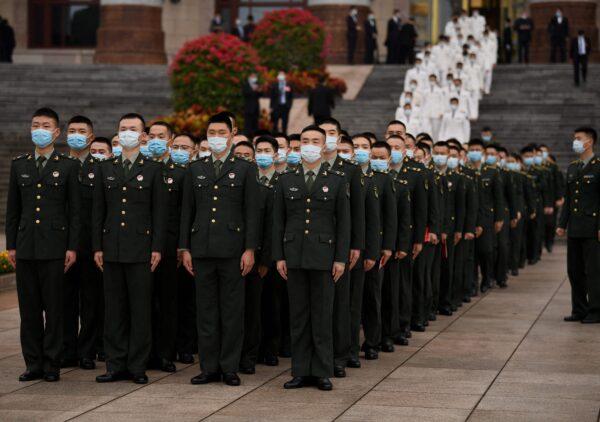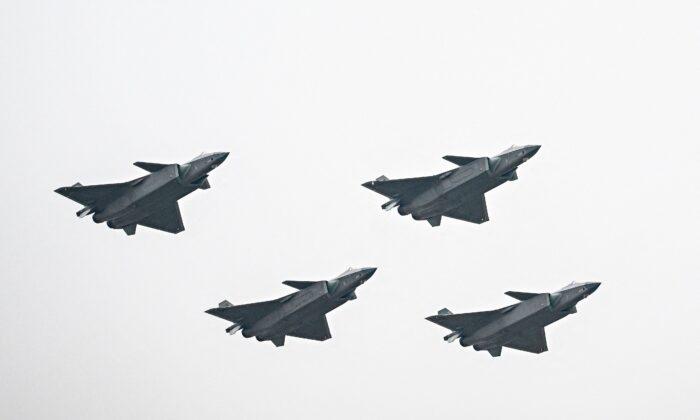China’s communist regime is developing its military to win a war against the United States by overwhelming its electronic, information, and logistical systems, according to an annual report by the Pentagon.
Information Domination
The CCP’s massive military modernization and expansion is no secret. Its military wing, the People’s Liberation Army (PLA), now boasts 2.2 million active-duty military service members and 660,000 paramilitary personnel, as well as 340 ships and submarines and more than 2,800 aircraft.Despite its size, the CCP is developing the PLA to engage heavily in domains not traditionally associated with combat, including electronic, information, and psychological warfare.

“The PLA considers information operations (IO) as a means of achieving information dominance early in a conflict, and continues to expand the scope and frequency of IO in military exercises,” the report reads.
A similar effort focusing on electronic and information warfare is the regime’s “multi-domain precision warfare” (MDPW), which seeks to deny adversaries such as the United States access to vital regions and systems by using state-of-the-art technology, such as artificial intelligence and quantum computing, and to launch pinpoint counterattacks on vital U.S. infrastructure. This strategy folds domains such as electronic and psychological warfare together with traditional domains of war, such as sea, land, and air capabilities, to create a holistic framework for conducting war.
The report describes the CCP’s MDPW strategy as a “network information system-of-systems that incorporates advances in big data and artificial intelligence to rapidly identify key vulnerabilities in the U.S. operational system and then combine joint forces across domains to launch precision strikes against those vulnerabilities.”
To do that, the regime is attempting to “informatize” its forces to ensure maximum cohesion between troops and network systems.
“Chairman Xi Jinping has called for the PLA to create a highly informatized force capable of dominating all networks and expanding the country’s security and development interests,” the report reads.
“PRC [People’s Republic of China] military writings describe informatized warfare as the use of information technology to create an operational system-of-systems, which would enable the PLA to acquire, transmit, process, and use information during a conflict to conduct joint military operations across the ground, maritime, air, space, cyberspace, and electromagnetic spectrum domains.”
China Isn’t Aiming for 2nd Place
One reason for this shift in doctrine, aside from the goal of overcoming the relative U.S. technological advantage, is to create “international conditions” that are conducive to the regime’s aspiration to build a “great modern socialist country,” the report states.CCP leaders believe that global activities, including growing its global military presence, contribute to its efforts to create a “favorable” international environment for its national rejuvenation project, through which it seeks to displace the United States as the chief superpower in the world. Such efforts, the report found, include the expansion of the regime’s overseas military and paramilitary presence, as well as the proliferation of its own technologies and related supply chains.
To that end, the report states that the CCP is likely considering several locations for new overseas military bases and ports to expand its reach and contest the international supremacy of the United States.
“The PRC has likely considered Cambodia, Myanmar, Thailand, Singapore, Indonesia, Pakistan, Sri Lanka, United Arab Emirates, Kenya, Equatorial Guinea, Seychelles, Tanzania, Angola, and Tajikistan, among other places, as locations for PLA military logistics facilities,” the report reads.
The ultimate aim of the regime’s military development and corollary expansion is to eject the United States from the Indo-Pacific, displace it as the world superpower, and seize the levers of power necessary to increase its control over global events.
“Within the context of China’s national strategy, however, it is likely that the PRC will seek to develop a military by mid-century that is equal to—or in some cases superior to—the U.S. military, and that of any other great power that Beijing views as a threat to its sovereignty, security, and development interests,” the report reads.
“Given the far-reaching ambitions the CCP has for a rejuvenated China, it is unlikely that the Party would aim for an end state in which the PRC would remain in a position of military inferiority vis-à-vis the United States or any other potential rival.”






Friends Read Free